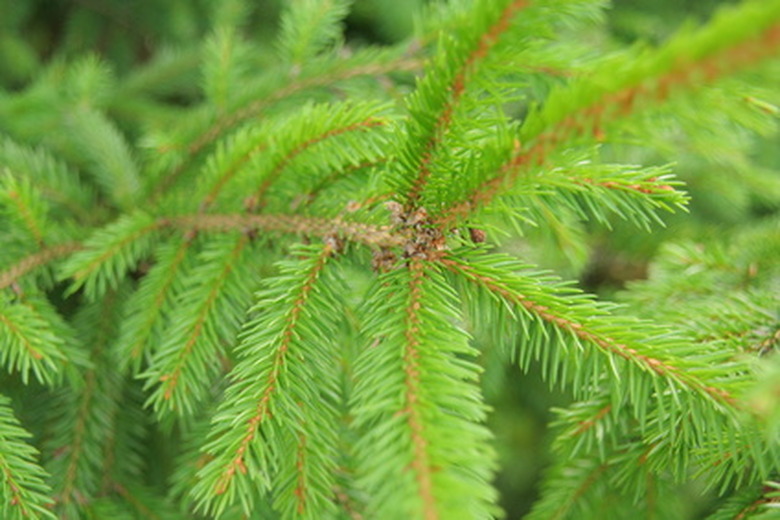How To Train A Weeping Norway Spruce
Things Needed
- 2-inch-by-2-inch wood stake or metal pole
- Sledgehammer
- Twine or plastic plant ties
- Hand pruners (secateurs)
- Heavy gauge wire
No two weeping Norway spruce (Picea abies Pendula) specimens resemble each other in habit, floppiness and beauty. The tree must be staked for the first one to three years after being planted to ensure the roots spread and strengthen enough to prevent the entire plant from flopping over. Trim away branches that touch soil so they do not root and form a carpet-like mat.
Step 1
Drive a 2x2-inch wooden stake or 1-inch diameter metal post into the ground 6 to 8 inches away from the trunk of the weeping Norway spruce. The length of the stake should be driven about 2 feet into the soil and extend to the height of or 6 inches beyond the top of the tree's main trunk. Make sure the stake is perfectly upright and is sturdy. It must support the weight and strain of the irregularly branched spruce without toppling or breaking.
- No two weeping Norway spruce (Picea abies Pendula) specimens resemble each other in habit, floppiness and beauty.
- The tree must be staked for the first one to three years after being planted to ensure the roots spread and strengthen enough to prevent the entire plant from flopping over.
Step 2
Snugly tie the top of the main trunk of the spruce to the stake with twine or green plastic plant ties. Do not use metal wire, which will slowly cut into and damage the bark of the plant. Allow a little wiggle room for the tree at the tie location to prevent any stress or breakage during wind storms.
Step 3
Examine the spruce tree's branches and form once it is staked. Remove any branch tips that touch the soil with the hand pruners, as they will root. You want to create a fully weeping plant with attractive branching. Also note if any dense branching causes the plant to look overly lopsided or causes the plant to be unstable or lean unsatisfactorily. Selective removal of small branches with the pruners can improve the look of the plant and help balance the weight load across the spruce.
- Snugly tie the top of the main trunk of the spruce to the stake with twine or green plastic plant ties.
- Allow a little wiggle room for the tree at the tie location to prevent any stress or breakage during wind storms.
Step 4
Coax horizontal or weeping branches from the main trunk to different positions by either tying them to the stake or taking sturdy but bendable wire and gently coiling it around the branches. Hold one end of the wire next to the branch and wrap the wire cautiously around the branch you wish to train. Bend the entire wire coil and branch gently to create the curve or form for the branch to follow.
Step 5
Consider driving in additional stakes to support larger, main horizontal branches that wire could not support or manipulate. Once the stake is driven into the ground and is sturdy, tie the branch to the stake at the desired height with twine or green plastic ties. Hide the stake in a manner so the weeping foliage masks its presence.
Step 6
Monitor the stability and growth of the weeping spruce and support stakes and ties twice a year, once before winter and again in mid-spring. Readjust ties or add/remove stakes as needed based on the growth and performance of the tree. Repeat Steps 1 through 5 as needed to keep the plant looking its best. Trim away branches and twigs as needed to maintain an attractive look.
- Coax horizontal or weeping branches from the main trunk to different positions by either tying them to the stake or taking sturdy but bendable wire and gently coiling it around the branches.
Step 7
Remove any upward-growing branches that look to be forming a new main vertical trunk if you wish to keep the weeping Norway spruce at a certain height. If the trunk of this tree is never pruned, it will grow with at least one trunk leader upward to heights of 20 feet and more.
Tip
Pruning, if needed, is best undertaken in spring before new needles grow. Spray paint wooden stakes a dark gray or matte black before using, as this color tends to disappear and not visually detract from the weeping Norway spruce. Do not fight the natural, awkward, splaying habit of the weeping spruce. This unique form makes each plant beautiful and visually intriguing. Plus, staking and supporting the plant on its strong trunk and branches will not require as much maintenance if you are merely tweaking the natural shape the plant is developing. Allow the weeping spruce to sprawl and ramble as a ground cover. This look is particularly stunning on a berm or rocky hillside.
Warning
Do not use too much pressure to the branch or wire if training a branch. Once the branch snaps, it is destined to brown and likely will die back to the wound. Keep metal or wood stakes from directly rubbing on branch bark, as it will create a wound, potentially leading to branch dieback or needle browning.
